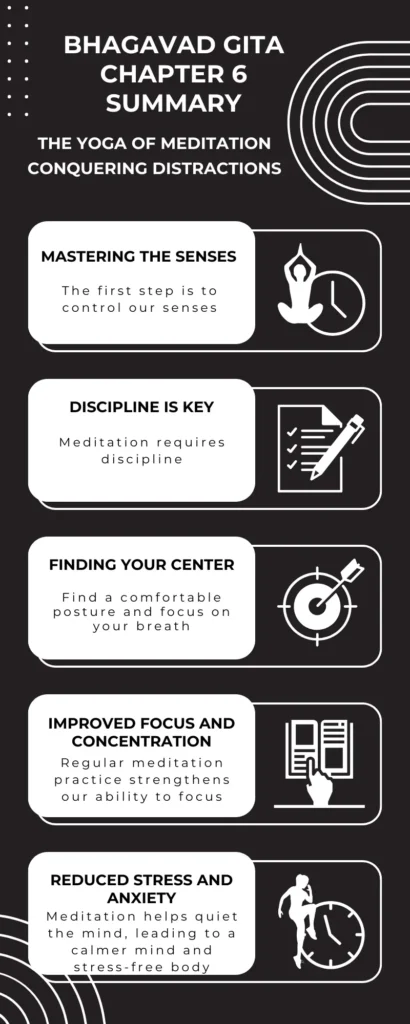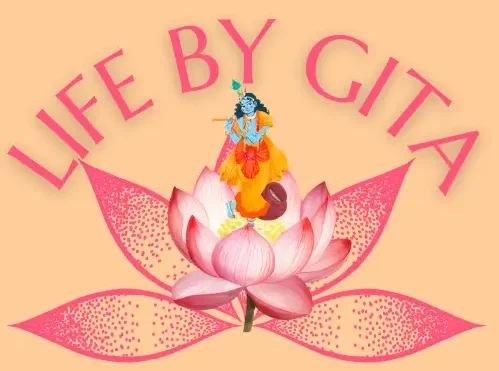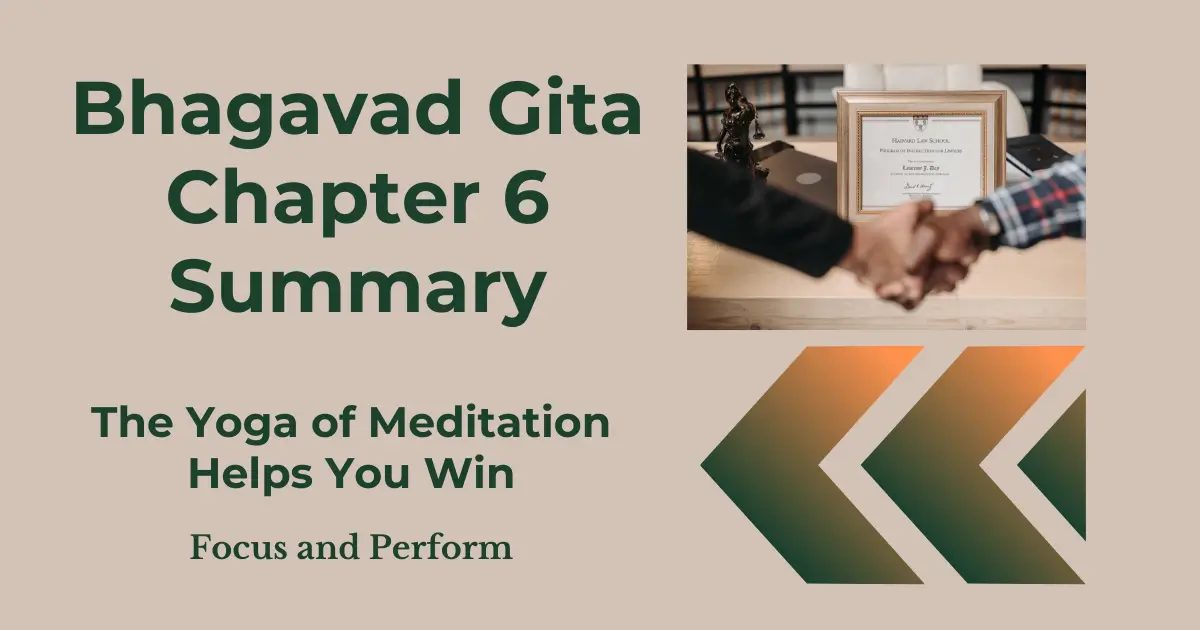
Welcome back to our Gita exploration! We left off with Chapter 5, where we delved into Karma Yoga, the art of performing actions without getting hung up on the outcome and the Renunciation, which can be achieved by pure mind and devotion. We had also seen the balance between them. Today, we are going to dive in the Summary of Chapter 6 of the Bhagavad Gita.
1. Introduction
Let’s be real, staying focused and detached in today’s world is like trying to herd cats – or maybe a more relatable image – like managing a dozen open tabs on your browser! Many people are trying to focus their scattered mind in order to work efficiently, but achieving this focus isn’t as easy as simply saying you will. So, what’s the solution? That’s where Bhagavad Gita Chapter 6, titled “Dhyana Yoga” (The Yoga of Meditation), comes in! The Bhagavad Gita, a timeless philosophical text, offers profound insights into various paths to spiritual liberation. Among these, Dhyana Yoga, the path of meditation, holds a special place. Chapter 6 delves deep into the intricacies of this practice, providing a roadmap for those seeking inner peace and union with the Divine.
2. Chapter 6 Dhyana Yoga Summary: The Path to Inner Peace and Union with the Divine
The Ideal Yogi: The Foundation of Meditation
Krishna, the divine charioteer, begins by painting a picture of the ideal yogi. This individual is a paragon of balance, detached from worldly desires, and dedicated to action without expectation. They possess a steady mind, body, and speech, finding solace in solitude. These qualities form the bedrock upon which the practice of meditation can flourish.
Preparing the Ground: Cultivating a Calm Mind
Before embarking on the meditation journey, Krishna emphasizes the importance of a calm and stable mind. This requires discipline in various aspects of life, including diet, physical activity, and mental control. A pure body and mind create a fertile ground for spiritual growth.
The Art of Meditation: Steps to Inner Stillness
The heart of Chapter 6 lies in the practical guidance for meditation. Krishna outlines a step-by-step process:
- Asana: Assuming a comfortable posture to facilitate focus.
- Pranayama: Regulating the breath to calm the mind.
- Pratyahara: Withdrawing the senses from external distractions.
- Dharana: Concentrating the mind on a single point (tip of your nose).
- Dhyana: Prolonged meditation on the chosen object.
- Samadhi: Complete absorption in the Divine.
By diligently practicing these steps, one can gradually attain a state of deep concentration and ultimately, union with the Supreme Being.
The Fruits of Meditation: A Rich Harvest
The rewards of dedicated meditation are immense. Krishna promises inner peace, spiritual growth, freedom from suffering, and, ultimately, liberation from the cycle of birth and death. Meditation is a powerful tool for transforming oneself and one’s relationship with the world.
Overcoming Challenges: The Path Less Traveled
The path to enlightenment is not without its obstacles. Restlessness and distractions are common challenges faced by meditators. Krishna offers guidance on overcoming these hurdles, emphasizing perseverance and patience.
The True Yogi: A Beacon of Light
The chapter culminates in a description of the true yogi, a being unaffected by life’s ups and downs, treating friends and foes with equanimity. This individual is firmly established in the Self and experiences constant divine bliss. Krishna extols the yogi as superior to ascetics, intellectuals, and those engaged in action. However, Krishna goes further, asserting that even the yogi is surpassed by a true devotee. The chapter concludes with the powerful statement that one who is full of faith, constantly abides in Krishna, thinks of Krishna within, and engages in loving service to Krishna is the most united with Krishna and the highest of all.
3. Conclusion: Bhagavad Gita Chapter 6 Summary
Chapter 6 of the Bhagavad Gita offers a comprehensive exploration of Dhyana Yoga, providing both philosophical insights and practical guidance. It inspires practitioners to embark on the journey of self-discovery and union with the Divine through the transformative power of meditation. By following the steps outlined and cultivating the qualities of an ideal yogi, one can experience the profound benefits of this ancient practice. However, the ultimate goal, as revealed by Krishna, lies in complete surrender and devotion to the Divine, surpassing even the heights attained through meditation.

4. Key Verses
Here are some key verses which are easy to understand:
1. “The Supreme God said: Someone who does their duty without worrying about the results is a true Sanyaasi or Yogi (spiritual seeker), even if they live a normal life, not someone who neither lights a fire nor performs any duty.”
– Verse 6.1
2. “For those seeking yoga, action is the path. For those who have achieved it, inaction becomes the path.”
– Verse 6.3
Action and Inaction in Yoga
The path to yoga is different for beginners and those who have mastered it.
- For those just starting their spiritual journey, action is essential. This means engaging in your duties and responsibilities without being attached to the outcomes. It’s about doing your part in the world while maintaining inner detachment.
- For those who have already achieved a high level of spiritual understanding, inaction or stillness becomes the focus. This doesn’t mean being lazy or unproductive, but rather, withdrawing from external activities and turning inward to deepen meditation and connection with the divine.
Essentially, action is a tool for growth, while inaction is a state of being attained through that growth.
3. “One who has relinquished all material desires, neither seeks gratification through the senses nor engages in actions driven by the pursuit of results, is considered to have attained a high level of yog.”
– Verse 6.4
4. “One must uplift oneself through the power of the mind, avoiding self-degradation for the mind is capable of being both the best friend and the worst enemy to oneself.”
– Verse 6.5
5. “The mind is a friend to those who master it, but a formidable enemy to those who have failed to do so.”
– Verse 6.6
6. “The Supreme Self who is self-controlled, peaceful and remains eternally established (devoted) to the Divine, transcending the fluctuations of cold and heat, pleasure and pain, honor and dishonor.”
– Verse 6.7
7. “Yogis, having conquered their senses and being satisfied by knowledge and discipline remain unfluctuating in all situations. They view everything—dirt, stones, and gold—with equal indifference.”
– Verse 6.8
8. “A yogi, viewing all beings—kindhearted, friends, foes, helpers, neutrals, and both the righteous and sinful—with an equal mind, is considered exceptionally wise.”
– Verse 6.9
9. “A yogi should live a solitary life, dedicated to cultivating a deep connection with the Divine through constant meditation, mind and body control, and detachment from worldly desires and possessions.”
– Verse 6.10
10. “The yogi should sit firmly and meditate with focused concentration, controlling the mind and senses to purify the heart.”
– Verse 6.12
11. “The yogi should maintain a straight posture, holding the body, neck, and head erect, with the gaze fixed steadily on the tip of the nose.”
– Verse 6.13
12. “With a calm, focused mind, free from fear and committed to the vow of celibacy (free from sexual desire), one should meditate on Me as the ultimate purpose.”
– Verse 6.14
13. “By consistently balancing the mind, the yogi, through disciplined control of body, mind, and actions, attains liberation, finds eternal abode in supreme peace, and ultimately merges with Me.”
– Verse 6.15
14. “O Arjuna, one cannot achieve the state of yoga by eating too much or too little. Similarly, excessive or insufficient sleep prevents one from achieving yoga.”
– Verse 6.16
15. “Those who maintain moderation in eating, sleeping, recreation, and work, can alleviate suffering through the practice of yoga.”
– Verse 6.17
16. “Through rigorous mental training, individuals redirect their focus from personal desires to a higher, universal consciousness. Liberated from the constraints of sensory cravings, they attain a state of profound spiritual realization (Yog), transcending the material world and finding ultimate fulfillment in union with the Divine.”
– Verse 6.18
17. “When the mind, through yogic practice, is stilled and purified by withdrawal from material pursuits, the yogi experiences direct perception of the soul (Self), and enjoys the profound inner joy.”
– Verse 6.20
18. “In that state of inner joy of transcendental unity (samadhi), one experiences infinite joy through transcendental perception and never departs from the ultimate reality.”
– Verse 6.21
19. “Having attained this state, one considers nothing superior. Established in this state, one is never shaken even in the face of greatest adversity.”
– Verse 6.22
20. “Yoga, a state of severance from union with the suffering (detachment from suffering). This Yog should be practiced with unwavering determination and free from negativity.”
– Verse 6.23
21. “By completely relinquishing all worldly desires born of mental speculation, one should steadfastly engage in yoga practice. With unwavering determination and faith, the mind should be employed to control the senses from all directions, remaining steadfast on the path without deviation.”
– Verse 6.24
22. “Through gradual, steadfast practice and with unwavering intellectual conviction, the mind should be steadily focused solely on the Self (Divine) and should not think of anything else.”
– Verse 6.25
23. “Whenever the restless and unsteady mind wanders due to its unstable nature, it must be persistently drawn back and refocused on the Self (Divine).”
– Verse 6.26
24. “A yogi with a calm mind and controlled passions, free from sin and who has realized the ultimate reality (Divine/ Brahman) attains the supreme bliss of union with the Divine.”
– Verse 6.27
25. “The self-controlled yogi, through disciplined yog practice, becomes free from all material impurities by uniting with the Divine. In constant contact with the Divine, they attain the ultimate state of perfect bliss.”
– Verse 6.28
26. “A true yogi perceives the Divine Self in all beings and all beings within the Divine. Through union with the Divine (Yog), they recognize the Supreme Lord’s presence everywhere, perceiving all creation as one.”
– Verse 6.29
27. “For those who perceive Me everywhere and everything in Me, there is no separation; neither I from them nor they from Me.”
– Verse 6.30
28. “The yogi, united with Me and worshiping Me as the Supreme Soul dwelling within all, remains eternally in Me, even while engaged in worldly activities.”
– Verse 6.31
29. “A perfect yogi, by recognizing the shared essence of self, perceives the inherent equality of all beings, feeling a profound connection to their joys and sorrows.”
– Verse 6.32
30. Lord Krishna said, “O mighty-armed son of Kunti, you’re right, it’s hard to control your mind but with consistent practice and detachment, you can bring it under control.”
– Verse 6.35
31. “Yoga is challenging for the uncontrolled mind, but those who control their mind and practice diligently with the right methods can undoubtedly achieve success. That is My view.”
– Verse 6.36
32. The Supreme Lord declared, “O Partha, one dedicated to the spiritual path faces no destruction in this world or the next. Such a devoted soul, engaged in virtuous endeavors, is forever protected from evil.”
– Verse 6.40
33. “Those who fail to achieve yogic perfection eventually find themselves in the celestial realms. After staying there for many years, they are subsequently reborn on Earth within families of either spiritual inclination or material abundance.”
– Verse 6.41
This verse describes the fate of individuals who do not reach the highest level of yoga, or yogic perfection.
- “Those who fail to achieve yogic perfection eventually find themselves in the celestial realms”: This part indicates that individuals who are unable to attain the ultimate goal of yoga end up in heavenly or divine places after death.
- “After staying there for many years, they are subsequently reborn on Earth”: This part suggests that after spending a significant period in these heavenly realms, these individuals are born again on Earth.
- “within families of either spiritual inclination or material abundance”: This final part specifies the kind of families these individuals are born into upon their return to Earth. They either end up in families that are spiritually oriented or those that are wealthy and prosperous.
Essentially, the sentence outlines a concept of rebirth based on the merits or demerits accrued during one’s life and the subsequent afterlife. Those who make progress on the yogic path but don’t reach the pinnacle still experience a positive outcome in the afterlife but eventually return to Earth in favorable circumstances.
34. “Alternatively, those who cultivate detachment through prolonged yogic practice are reborn into families of profound spiritual wisdom. Such a birth is exceedingly rare in this world.”
– Verse 6.42
35. “Upon such rebirth, they recall the wisdom gained in previous lives and redouble their efforts to attain yogic perfection, O son of the Kurus.”
– Verse 6.43
36. “Driven by the momentum of past spiritual discipline, such souls are irresistibly drawn to the Divine. These souls transcend the confines of ritualistic scriptures.”
– Verse 6.44
37. “Drawing upon the collective wisdom of countless lifetimes, dedicated spiritual practice in making further progress purifies the soul, culminating in liberation from worldly desires and realization of the ultimate truth.”
– Verse 6.45
This verse describes the path to spiritual enlightenment or liberation within a philosophical or religious context.
- Drawing upon the collective wisdom of countless lifetimes: This part suggests that the individual’s spiritual journey is not isolated but benefits from the experiences and knowledge accumulated over many past lives.
- dedicated spiritual practice in making further progress: This indicates that consistent and focused effort on the spiritual path is essential.
- purifies the soul: This suggests that through spiritual practice, the individual’s inner self is cleansed of impurities or negative qualities.
- culminating in liberation from worldly desires and realization of the ultimate truth: This signifies the final goal of the spiritual journey: freedom from material attachments and the attainment of profound spiritual understanding or enlightenment.
Essentially, the verse conveys the idea that by utilizing the wisdom gained from past lives and through persistent spiritual practice, one can purify their soul and ultimately achieve liberation and enlightenment.
Now, the question should be “how is it possible to recall the wisdom gained from past lives?”
Subconscious Influence: There is no need to recall. The wisdom of past lives influences us subconsciously, shaping our personality, choices, and inclinations without explicit recall.
38. “A yogi surpasses the ascetic, the intellectual, and the ritualist. Therefore, O Arjuna, aspire to become a yogi.”
– Verse 6.46
39. “Those yogis who are eternally immersed in Me, filled with profound faith, and dedicated to My devotional service are the highest of all, according to Me.”
– Verse 6.47
5. Key Points to remember
The following are the key points of Dhyan Yog which should be remembered:
- Importance of a Calm Mind: A stable mind is essential for meditation and spiritual growth.
- Steps to Meditation: Asana (posture), Pranayama (breath control), Pratyahara (sense withdrawal), Dharana (concentration), Dhyana (meditation), Samadhi (absorption).
- Qualities of a Yogi: Balance, detachment, self-control, inner peace.
- Benefits of Meditation: Overcoming mental disturbances, spiritual growth, freedom from suffering, union with the Divine.
- Overcoming Challenges: Persistence, patience, and specific techniques to handle distractions.
- Superiority of the Yogi: The yogi is considered superior to ascetics, intellectuals, and those engaged in action.
- Ultimate Goal: Union with the Supreme Being through devotion and surrender.
If you want to read this summary offline then, you can download the pdf version below:
Bhagavad Gita Chapter 6 Summary pdf
6. FAQ
Q1: Is meditation difficult?
A: Meditation takes practice, but even a few minutes a day can make a difference.
Q2: What are some good meditation techniques for beginners?
A: Focusing on your breath is a simple and effective technique.
Q3: How can I incorporate the teachings of Chapter 6 into my daily life?
A: Start by setting aside time for regular meditation and introspection. Practice self-discipline by gradually reducing dependence on external distractions. Cultivate mindfulness in everyday activities, focusing on the present moment with awareness and intention.
Remember, the Bhagavad Gita is a timeless guide for navigating life’s challenges. By incorporating its wisdom into our daily lives, we can find inner peace and achieve true happiness.
Must Read: What is the message of the Bhagavad Gita?
If you have any comment or question, feel free to leave in the comment box at the bottom.
Sources used for Reference:
- Bhagavad Gita As It Is
- The Holy Bhagavad Gita
- Shlokam
- The Bhagavad Gita by Eknath Easwaran
- Some others if needed
Disclaimer: While this blog post draws inspiration from various sources, including but not limited to the above list, the content presented here is original and represents the author’s interpretation and understanding of the subject matter. No part of this content has been copied verbatim from the listed sources.
Further Reading
Mindful.org: This website offers a variety of resources on mindfulness and meditation, including techniques for improving focus.


